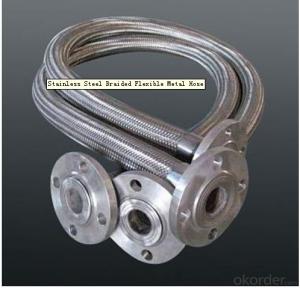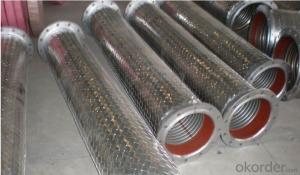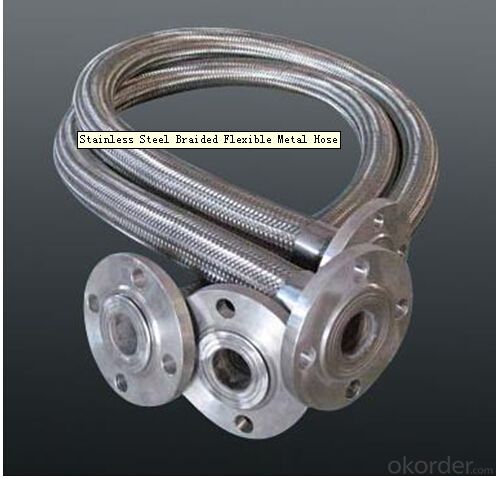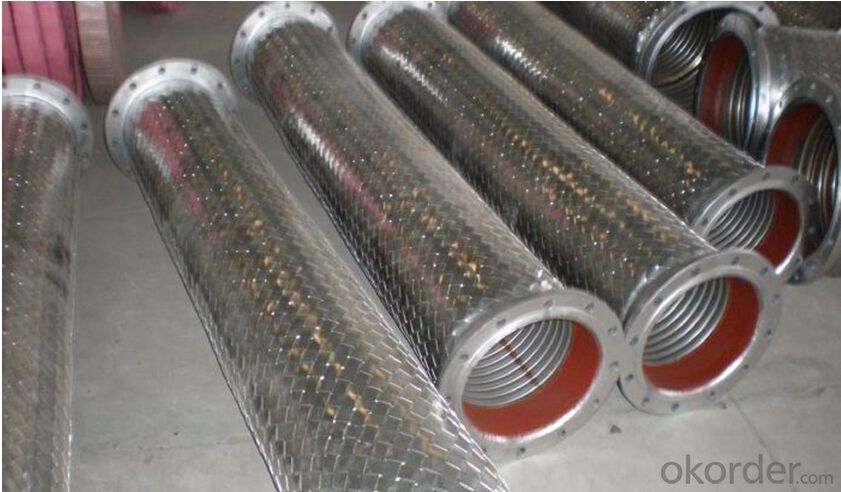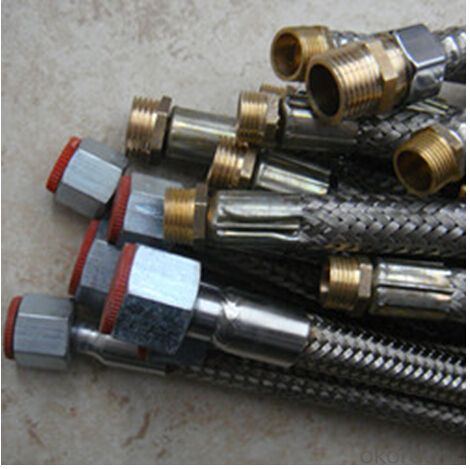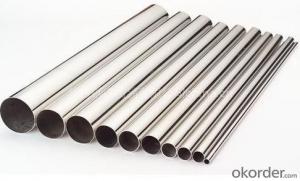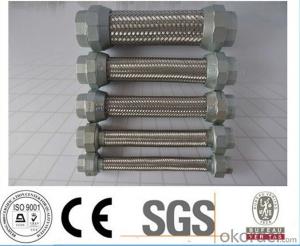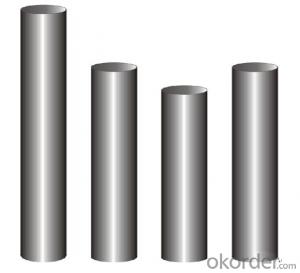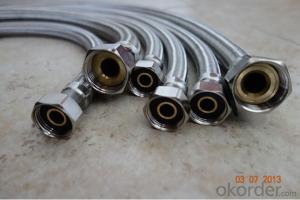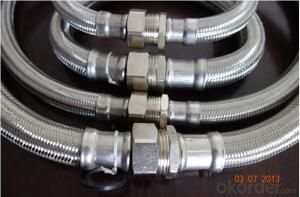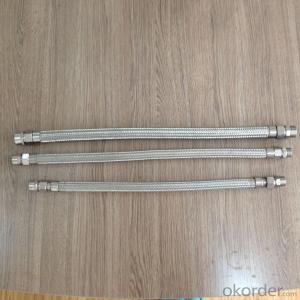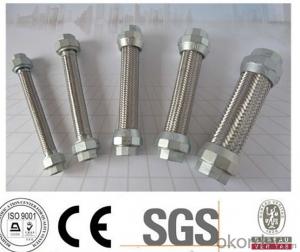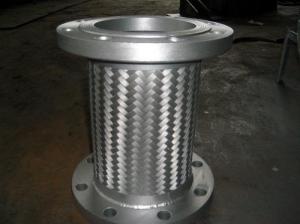Metal Braided Hose with Flexible Material
- Loading Port:
- Tianjin
- Payment Terms:
- TT OR LC
- Min Order Qty:
- 1000 pc
- Supply Capability:
- 100000 pc/month
OKorder Service Pledge
OKorder Financial Service
You Might Also Like
Specification
Metal Braided Hose with Flexible Material
Applications of Metal Braided Hose with Flexible Material:
--Refueling system
--Chemical and pharmaceutical industry
--Industrial hydraulic systems
--Air conditioners in industrial and construction –site vehicles
--Food and beverage industry
--Special and standard industrial applications
--Water and cleaning management
Features of Metal Braided Hose with Flexible Material:
1. )O. D.: 13-18MM 0.2-3M long
2. )Nut.: Nickel/Chrome Plated Brass (Zinc / Iron / Aluminum is available)
3. )Size Of Nut.: Female&Male 1/2''; 3/4''; 3/8''; 7/8''; 5/16'', and M10...
4. )Insert.: Brass (Zinc / Aluminum / Plastic is available)
5. )Inner tube.: Rubber/ EPDM/PVC
6. )Covered Material: Stainless Steel 201, 301, 304 /Aluminium Wire
7. )Working Pressure: 5Kg-15Kg
8. )Temperature: 0-92° C
9. )Quality Assurance: 3 years
RemarkAPPLICATION: HOUSEEHOLD WARE, BATHROOM WARE, SHOWER HOSE
PAYMENT: T/T, L/C
DELIVERY TIME: 20DAYS OR 30DAYS AFTER RECEIVED 30% DEPOSITS
MOQ: 5000PCS
ODM&OEM IS ACCEPTABLE
PackageInner: PP bag /Blister packing Outer: Carton box
Specifications of Metal Braided Hose with Flexible Material:
NO | I.D | Refer to O.D | Working pressure | Burst pressure | approximate Weight | |||||
(inch) | (mm) | (inch) | (mm) | MPa | Psi | MPa | Psi | kg/m | lbs/ft | |
1 | 1/8 | 3.2±0.2 | 0.35 | 9±0.3 | 2.06 | 300 | 8.27 | 1200 | 0.078 | 0.12 |
2 | 5/32 | 4±0.2 | 0.4 | 10±0.3 | 2.06 | 300 | 8.27 | 1200 | 0.092 | 0.14 |
3 | 3/16 | 4.8±0.2 | 0.43 | 11±0.3 | 2.06 | 300 | 8.27 | 1200 | 0.108 | 0.16 |
4 | 1/4 | 6.3±0.3 | 0.5 | 12.7±0.3 | 2.06 | 300 | 8.27 | 1200 | 0.134 | 0.2 |
5 | 5/16 | 8.0±0.3 | 0.56 | 14±0.3 | 2.06 | 300 | 8.27 | 1200 | 0.147 | 0.22 |
6 | 3/8 | 9.5±0.3 | 0.63 | 16±0.4 | 2.06 | 300 | 8.27 | 1200 | 0.182 | 0.27 |
7 | 15/32 | 12±0.3 | 0.75 | 19±0.5 | 2.06 | 300 | 8.27 | 1200 | 0.238 | 0.35 |
8 | 1/2 | 12.7±0.4 | 0.78 | 20±0.5 | 2.06 | 300 | 8.27 | 1200 | 0.262 | 0.39 |
9 | 5/8 | 16±0.4 | 0.94 | 24±0.5 | 1.03 | 150 | 4.12 | 600 | 0.351 | 0.52 |
10 | 3/4 | 19±0.4 | 1.13 | 28.8±0.5 | 1.03 | 150 | 4.12 | 600 | 0.515 | 0.77 |
11 | 1 | 25.4±0.5 | 1.38 | 35±0.6 | 1.03 | 150 | 4.12 | 600 | 0.637 | 0.95 |
Images of Metal Braided Hose with Flexible Material:
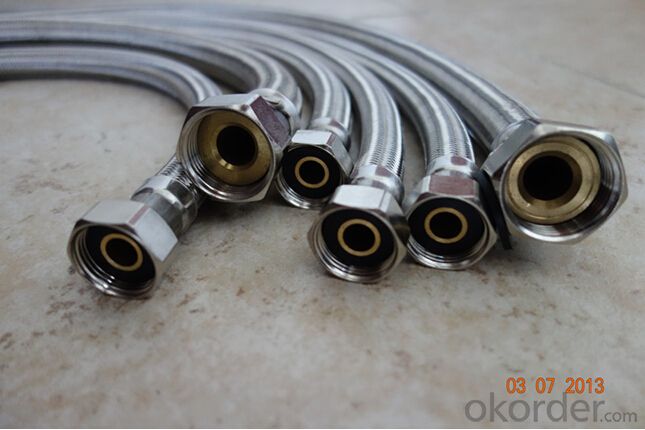
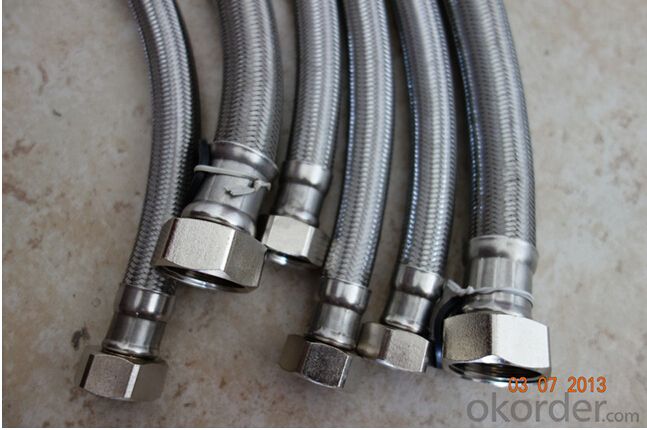
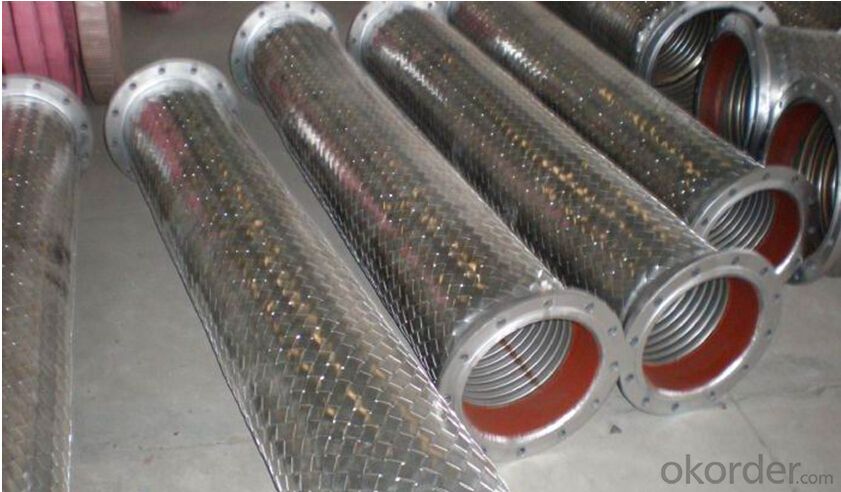
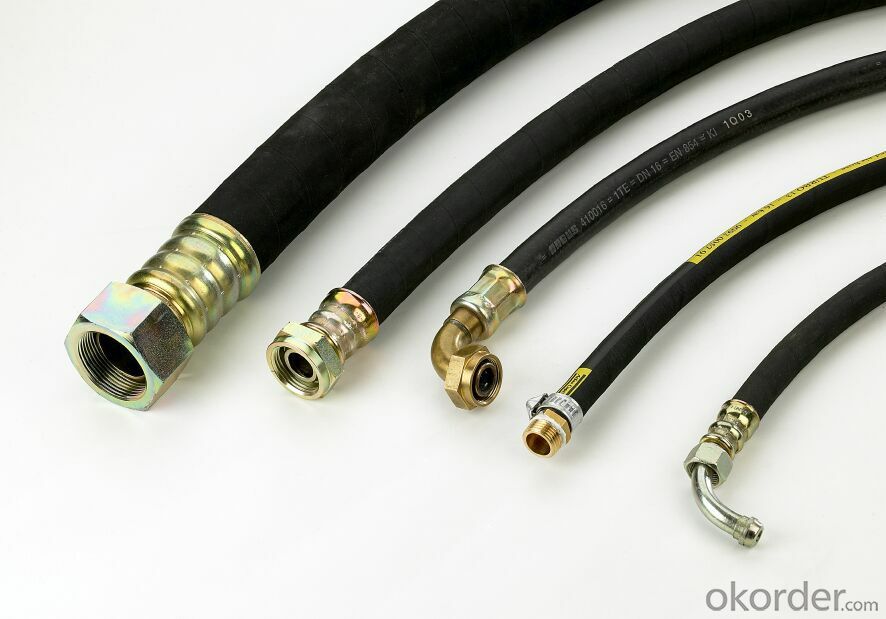
Package of Metal Braided Hose with Flexible Material:
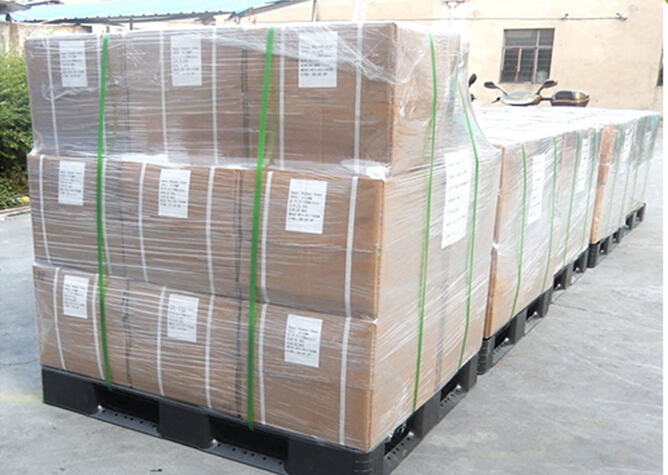

FAQ of Metal Braided Hose with Flexible Material:
Who we are:
Answer: We CNBM is a Chinese state-owned enterprise ranked 267th among the Global Fortune 500, as the largest building materials company,we have over 300 affiliated companies,and so many production lines and branch office distribute in China.
2. About our quality:
Answer: Every product needs to be quality proved before shipping.
3. About our service:
Answer: We could gurantte that we can reply you in 2 working hours.
- Q: How do you prevent clogging in stainless steel pipes?
- To prevent clogging in stainless steel pipes, there are several measures that can be taken: 1. Regular maintenance: It is important to perform regular maintenance on stainless steel pipes to prevent clogging. This includes periodic inspection and cleaning to remove any build-up or debris that may lead to blockages. 2. Proper disposal of waste: Ensure that only appropriate materials are disposed of in the pipes. Avoid flushing or introducing items such as paper towels, sanitary products, or grease down the drain, as these can accumulate and cause clogs. 3. Use drain filters: Install drain filters or strainers at the openings of the pipes to catch any large particles or debris that could potentially cause clogs. These filters can be cleaned regularly or replaced as needed. 4. Avoid corrosive materials: Some chemicals or substances can corrode stainless steel pipes, leading to damage and potential clogs. It is important to avoid using corrosive materials in or near the pipes and to follow manufacturer guidelines for chemical usage. 5. Proper water flow: Ensure that there is adequate water flow through the pipes to prevent clogging. This can be achieved by running water regularly, especially for pipes that are not frequently used. 6. Consider water softeners: If the water supply is particularly hard, it may contain minerals that can build up and eventually clog the pipes. Installing a water softener can help reduce mineral deposits and prevent clogs. 7. Seek professional help: If you experience persistent clogging or are unsure of how to prevent it, it is recommended to consult with a professional plumber. They can assess the situation, provide guidance on preventive measures, and address any existing clogs effectively. By following these preventive measures, you can minimize the risk of clogs in stainless steel pipes and ensure the smooth operation of your plumbing system.
- Q: Can stainless steel pipes be insulated with polyethylene-co-methacrylate?
- No, stainless steel pipes cannot be insulated with polyethylene-co-methacrylate.
- Q: Can stainless steel pipes be used for firefighting systems?
- Yes, stainless steel pipes can be used for firefighting systems. Stainless steel is a durable and corrosion-resistant material, making it suitable for such applications where durability and resistance to heat and pressure are required.
- Q: Where is the difference between seamless steel pipe and welded pipe?
- Seamless steel tube is formed during rolling. Welded steel pipes need to be welded after coiling, and spiral welding and direct welding are generally used. Seamless performance is better, of course, the price is higher.
- Q: What are the common types of fittings used with stainless steel pipes?
- There are several common types of fittings used with stainless steel pipes. Some of the most commonly used fittings include: 1. Stainless Steel Threaded Fittings: These fittings have threaded ends that allow them to be easily connected to pipes or other fittings. They are typically used in low-pressure applications and can be easily installed or removed using a wrench. 2. Stainless Steel Butt-Weld Fittings: Butt-weld fittings are used to connect stainless steel pipes with a seamless method. These fittings are welded directly to the pipe, providing a strong and leak-free connection. Butt-weld fittings are commonly used in high-pressure or high-temperature applications. 3. Stainless Steel Flanges: Flanges are used to connect pipes or fittings together by bolting them together. They provide a secure and rigid connection that can be easily disassembled when needed. Flanges are available in various types such as slip-on, weld neck, socket weld, and blind flanges. 4. Stainless Steel Compression Fittings: Compression fittings are used to create a tight seal between pipes by compressing a ferrule against the pipe. They are commonly used in plumbing systems and provide a reliable and leak-free connection. 5. Stainless Steel Camlock Fittings: Camlock fittings are quick-connect fittings that are commonly used in industrial applications. They have a male and female end that can be easily connected by simply pushing them together and then locking them in place. Camlock fittings are known for their ease of use and versatility. Overall, these are some of the common types of fittings used with stainless steel pipes. The choice of fitting depends on the specific application, pressure, temperature, and other factors. It is important to select the right fitting to ensure a secure and reliable connection.
- Q: What is the welding of stainless steel?
- If batch welding, it is recommended to use laser welding, welding heat affected area is small, weld appearance, speed, more suitable for thin plate,
- Q: Can stainless steel pipes be used for oil refinery applications?
- Oil refinery applications can indeed use stainless steel pipes. Due to its exceptional resistance to corrosion, high durability, and strength, stainless steel is widely utilized in the oil and gas industry. Oil refineries face harsh and corrosive environments, including exposure to various chemicals, high temperatures, and pressure. Stainless steel pipes have the ability to withstand these conditions and provide long-lasting performance. Stainless steel pipes possess resistance to corrosion resulting from acidic and alkaline substances, which are commonly present in oil refinery operations. They also exhibit excellent resistance against pitting and crevice corrosion, making them ideal for handling crude oil, petroleum products, and other corrosive media. Moreover, stainless steel pipes can handle high temperatures without compromising their strength and integrity. This quality is crucial in oil refineries where heating and cooling processes are involved. Apart from corrosion resistance and high-temperature capabilities, stainless steel pipes also possess exceptional mechanical properties. They are robust, durable, and possess good weldability, making them suitable for the demanding conditions of oil refinery applications. In conclusion, stainless steel pipes are a reliable option for oil refinery applications due to their corrosion resistance, high-temperature capabilities, and mechanical properties. They ensure the safe and efficient transportation of oil and petroleum products, thereby contributing to the seamless operations of oil refineries.
- Q: How do stainless steel pipes compare to other materials like carbon steel or PVC?
- When it comes to various applications, stainless steel pipes have several advantages over other materials such as carbon steel or PVC. Firstly, stainless steel pipes are well-known for their excellent corrosion resistance. They can resist rust, oxidation, and staining, making them suitable for use in environments with high moisture or chemical exposure. In contrast, carbon steel pipes are prone to corrosion and require protective coatings to prevent rusting, while PVC pipes are not resistant to certain chemicals and can degrade over time. Secondly, stainless steel pipes provide exceptional strength and durability. They can withstand high pressure and extreme temperatures, making them ideal for applications that require robust and long-lasting piping systems. Carbon steel pipes also have good strength characteristics, but they may not be as corrosion-resistant as stainless steel. On the other hand, PVC pipes are relatively weaker and may not be suitable for high-pressure applications. Furthermore, stainless steel pipes have excellent hygienic properties. They are non-porous, smooth, and easy to clean, making them suitable for use in industries such as food and beverage, pharmaceuticals, and healthcare, where cleanliness and prevention of bacterial growth are crucial. Carbon steel pipes, due to their porous nature, can accumulate contaminants and bacteria over time. PVC pipes, although easy to clean, may release certain chemicals into the water or fluids passing through them, which can be a concern in certain applications. Lastly, stainless steel pipes are highly versatile. They can be used in a wide range of applications, including water supply, gas pipelines, chemical processing, oil and gas exploration, and architectural purposes. Carbon steel pipes are also versatile but may require additional measures to prevent corrosion. PVC pipes, while suitable for certain applications, have limitations in terms of temperature and pressure ratings. In summary, stainless steel pipes offer superior corrosion resistance, strength, durability, and hygienic properties compared to carbon steel or PVC pipes. When choosing a piping material, it is important to consider the specific requirements of the application to ensure optimal performance and longevity.
- Q: Are stainless steel pipes suitable for vacuum systems?
- Yes, stainless steel pipes are suitable for vacuum systems. Stainless steel is known for its high strength, durability, and resistance to corrosion, making it an excellent choice for vacuum applications. It offers a high level of leak-tightness, ensuring that the vacuum system can maintain the desired level of vacuum without any loss. Stainless steel pipes also have low outgassing rates, which is crucial in maintaining a clean and contaminant-free vacuum environment. Additionally, stainless steel is compatible with a wide range of gases and fluids commonly used in vacuum systems, making it a versatile material for various applications. Overall, stainless steel pipes are a reliable and effective option for vacuum systems due to their excellent mechanical properties and resistance to both internal and external factors that can affect the performance of the vacuum.
- Q: Can stainless steel pipes be used for hydraulic systems?
- Stainless steel pipes are a suitable option for hydraulic systems as they possess high durability and resistance to corrosion. This material can withstand high pressure and extreme temperatures, making it a dependable choice for hydraulic applications. In addition, stainless steel pipes exhibit exceptional resistance to chemical and environmental elements, guaranteeing the longevity and reliability of the hydraulic system. Moreover, these pipes provide excellent dimensional stability, which is critical for maintaining the integrity and efficiency of the hydraulic system. In summary, stainless steel pipes are widely favored for hydraulic systems due to their durable nature, corrosion resistance, and exceptional performance capabilities.
Send your message to us
Metal Braided Hose with Flexible Material
- Loading Port:
- Tianjin
- Payment Terms:
- TT OR LC
- Min Order Qty:
- 1000 pc
- Supply Capability:
- 100000 pc/month
OKorder Service Pledge
OKorder Financial Service
Similar products
Hot products
Hot Searches
Related keywords
